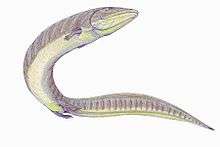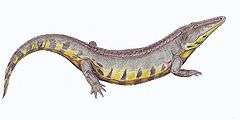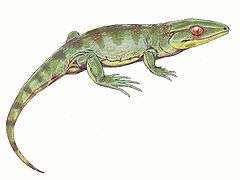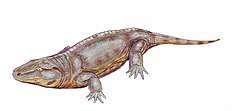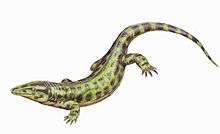Ambedus
Ambedus is an extinct genus of diadectid reptiliomorph. Fossils have been found from the Early Permian Dunkard Group of Monroe County, Ohio. The type species A. pusillus was named in 2004. The genus name comes from the Latin word ambedo meaning "to nibble", in reference to its herbivorous diet. The specific name pusillus means "tiny" in Latin.
| Ambedus Temporal range: Early Permian | |
|---|---|
| Scientific classification | |
| Kingdom: | Animalia |
| Phylum: | Chordata |
| Order: | †Diadectomorpha |
| Family: | †Diadectidae |
| Genus: | †Ambedus Kissel and Reisz, 2004 |
| Species | |
| |
Description
Ambedus is a small diadectid known only from maxillae and dentary bones. It is considered the most primitive diadectid because unlike other forms it had a small, shallow lower jaw and many simple, conical teeth. It was also smaller than the later, rather bulky diadectids. Later diadectids have deep jaws with few teeth and forward-projecting incisiforms at the tips of the jaws for consuming plant material, and a corresponding greater girth.[1]
Paleobiology
The holotype specimen of Ambedus was found from an outcrop of the Early Permian the Greene Formation on Clark Hill in Monroe County, Ohio. It was found alongside fossils of the lungfish Sagenodus, the temnospondyl amphibian Trimerorhachis, an embolomere reptiliomorph, and the synapsid Ctenospondylus. These animals likely lived alongside a freshwater lake or pond.[1]
References
- Kissel, R.A.; Reisz, R.R. (2004). "Ambedus pusillus, new genus, new species, a small diadectid (Tetrapoda: Diadectomorpha) from the Lower Permian of Ohio, with a consideration of diadectomorph phylogeny". Annals of the Carnegie Museum. 71: 197–212.
